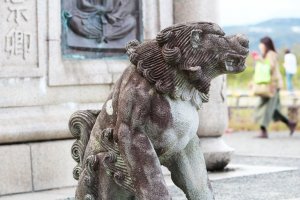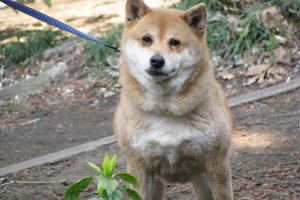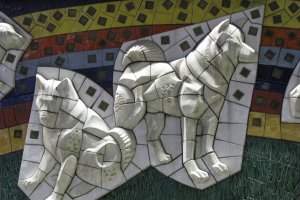Inu, as dogs are known in Japanese, are most often represented in folklore as the defenders of people. Traditional belief has it that inu have a magical ability to resist evil spirits and demons. They frighten away kitsune foxes and other such creatures, with dog figures often placed at a city's gates to ward off thieves and robbers.
The legend of the Akita-inu
A long time ago, a kind and honest elderly couple lived in a village. The kind old man had a favorite dog, an Akita-inu. One day, the dog pulled his master into the garden, barking and digging at the ground. The old man began to dig and soon uncovered gold, silver and precious stones which he brought back home. A neighbor who visited became envious when he saw the treasure and asked where it had come from. The old couple told him, offering their dog to help him find some treasure. The neighbor took the dog, dug at the spot but found only snakes, lizards and worms. In a rage, the man killed the dog, sticking a willow twig in the ground where he had buried it.
The kind old man began to worry when his dog didn't return. He went to the neighbor and learned about the sad fate of his pet. Visiting his dog's grave site, he saw a tall willow tree. He cut it down to make a mortar out of it. When the old man began to grind rice in the mortar, gold coins fell from it. A neighbor who saw what had happened, begged to borrow the mortar. When he began grinding rice in it, though, disgusting creatures appeared. In anger, the neighbor threw the mortar into the fireplace. When the kind old man came for his mortar, he received only its ashes.
Going home with his ashes, some fell through his fingers onto the dry grass, turning it green. Climbing a tree in his garden, he then scattered the ashes and all the trees suddenly began blooming with beautiful springtime flowers. Many people came to see this wonder, shouting in admiration but again the neighbor envied. This time, he took some remaining ash, climbed a tree in his garden and scattered them. People gathered to watch but instead of blossoming buds, the ashes from the hands of the envious neighbor got into the people's eyes, making them ache in pain. The people turned on the envious neighbor, giving him what he deserved.

Guardian Lion Dogs
One legend has it that the Buddha was accompanied by small dogs on his wanderings. Whenever he tired, his companions turned into lions to carry him and protect him from enemies. At the entrances to Buddhist temples, you will often find komainu lion dog sculptures.
Japanese Spaniel
A lap species, Chin Dogs bring joy with their unusual appearance and playful but dignified characters. Considered almost sacred over the centuries, the breed was much favoured by the Imperial court, often having their own guards, servants and doctors. This rare and precious creature, nicknamed chinkoro as a result, has an unusual origin story.
Once a lion came to the Buddha for advice. The lion was in love with a small monkey, but because of their differences, the two could not become a couple and both suffered for it. The Buddha said that he could help but warned the lion that he would become small, losing his strength and status. The lion agreed to this and the two animals were reunited. From their union the charming chin dog was born. Also known as the Japanese Spaniel, this dog took the best features from her parents - intelligence, cunning, courage and a heart full of love for the world.
Hachiko
An Akita-inu was given to Professor Ueno, who was very fond of dogs, and already had seven of them. Being the eighth dog, he was called Hachiko (hachi means eight, ko is a suffix often added to endearing children or pets). Attached to the professor, Hachiko accompanied him daily to Shibuya station, and then waiting for him to return home.
A year and a half later, the professor passed away from a stroke. Hachiko, however, continued to come to the station each day before spending the night on the porch of Ueno's house. By 3pm the next day, he was back at the station. This lasted for 7 years before an about it was published in a newspaper. The story touched the hearts of people who began to come from all over Japan to sympathise with the dog.
Hachiko survived his owner by 9 years - he was found dead on March 8, 1935 near the station. Hachiko's death was perceived as a national grief and was buried in Tokyo's Aoyama Cemetery. The bronze monument at Shibuya Station was installed in 1934, with another monument at the University of Tokyo.

Dogs in Antarctica
To move through the snow and ice during the Japanese Antarctic research expedition of 1958, the scientists brought with them 13 Sakhalin Huskies. At the end of the expedition, due to a powerful storm, it was ordered to save only people and the most valuable equipment. With heavy hearts, the dogs were tied up and left on the icy shore with a week's supply of food. The polar explorers were naturally worried about the dogs and tried to return, but the weather conditions made it impossible.
The Japanese took the situation painfully and blamed the participants of the expedition for the death of the dogs. Fundraising began for a monument to the dogs which was erected at the foot of Tokyo Tower in 1958.

What made this story incredible was that a year later, in 1959, another expedition arrived at the research station, only to be met by two live huskies - Taro and Jiro! The two dogs managed to free themselves and lived for a whole year without people. The news about the two rescued huskies quickly reached Japan, where it was met with general jubilation. The two dogs became national heroes. The monument to the huskies is located at the Institute of Polar Research (Polar Science Musuem) in Tokyo, Takamatsu Station.
































